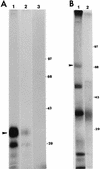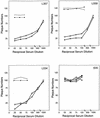Functional role of hepatitis C virus chimeric glycoproteins in the infectivity of pseudotyped virus
- PMID: 9557633
- PMCID: PMC109573
- DOI: 10.1128/JVI.72.5.3539-3546.1998
Functional role of hepatitis C virus chimeric glycoproteins in the infectivity of pseudotyped virus
Abstract
The putative envelope glycoproteins of hepatitis C virus (HCV) likely play an important role in the initiation of viral infection. Available information suggests that the genomic regions encoding the putative envelope glycoproteins, when expressed as recombinant proteins in mammalian cells, largely accumulate in the endoplasmic reticulum. In this study, genomic regions which include the putative ectodomain of the E1 (amino acids 174 to 359) and E2 (amino acids 371 to 742) glycoproteins were appended to the transmembrane domain and cytoplasmic tail of vesicular stomatitis virus (VSV) G protein. This provided a membrane anchor signal and the VSV incorporation signal at the carboxy termini of the E1 and E2 glycoproteins. The chimeric gene constructs exhibited expression of the recombinant proteins on the cell surface in a transient expression assay. When infected with a temperature-sensitive VSV mutant (ts045) and grown at the nonpermissive temperature (40.5 degrees C), cells transiently expressing the E1 or E2 chimeric glycoprotein generated VSV/HCV pseudotyped virus. The resulting pseudotyped virus generated from E1 or E2 surprisingly exhibited the ability to infect mammalian cells and sera derived from chimpanzees immunized with the homologous HCV envelope glycoproteins neutralized pseudotyped virus infectivity. Results from this study suggested a potential functional role for both the E1 and E2 glycoproteins in the infectivity of VSV/HCV pseudotyped virus in mammalian cells. These observations further suggest the importance of using both viral glycoproteins in a candidate subunit vaccine and the potential for using a VSV/HCV pseudotyped virus to determine HCV neutralizing antibodies.
Figures




Similar articles
-
Coexpression of hepatitis C virus E1 and E2 chimeric envelope glycoproteins displays separable ligand sensitivity and increases pseudotype infectious titer.J Virol. 2004 Dec;78(23):12838-47. doi: 10.1128/JVI.78.23.12838-12847.2004. J Virol. 2004. PMID: 15542636 Free PMC article.
-
Influence of N-linked glycans on intracellular transport of hepatitis C virus E1 chimeric glycoprotein and its role in pseudotype virus infectivity.Virology. 2004 Jul 1;324(2):273-85. doi: 10.1016/j.virol.2004.03.039. Virology. 2004. PMID: 15207615
-
Characterization of pseudotype VSV possessing HCV envelope proteins.Virology. 2001 Aug 1;286(2):263-75. doi: 10.1006/viro.2001.0971. Virology. 2001. PMID: 11485395
-
Hepatitis C virus envelope glycoproteins and potential for vaccine development.Vox Sang. 2002 Aug;83 Suppl 1:27-32. doi: 10.1111/j.1423-0410.2002.tb05262.x. Vox Sang. 2002. PMID: 12617098 Review.
-
Cloning, expression, and functional analysis of patient-derived hepatitis C virus glycoproteins.Methods Mol Biol. 2007;379:177-97. doi: 10.1007/978-1-59745-393-6_13. Methods Mol Biol. 2007. PMID: 17502679 Review.
Cited by
-
Development and Applications of VSV Vectors Based on Cell Tropism.Front Microbiol. 2012 Jan 18;2:272. doi: 10.3389/fmicb.2011.00272. eCollection 2011. Front Microbiol. 2012. PMID: 22279443 Free PMC article.
-
Functional characterization of intracellular and secreted forms of a truncated hepatitis C virus E2 glycoprotein.J Virol. 2000 Jan;74(2):702-9. doi: 10.1128/jvi.74.2.702-709.2000. J Virol. 2000. PMID: 10623732 Free PMC article.
-
Cell fusion activity of hepatitis C virus envelope proteins.J Virol. 2000 Jun;74(11):5066-74. doi: 10.1128/jvi.74.11.5066-5074.2000. J Virol. 2000. PMID: 10799580 Free PMC article.
-
The hypervariable region 1 of the E2 glycoprotein of hepatitis C virus binds to glycosaminoglycans, but this binding does not lead to infection in a pseudotype system.J Virol. 2004 May;78(9):4478-86. doi: 10.1128/jvi.78.9.4478-4486.2004. J Virol. 2004. PMID: 15078928 Free PMC article.
-
Characterization of vesicular stomatitis virus recombinants that express and incorporate high levels of hepatitis C virus glycoproteins.J Virol. 2002 Jul;76(14):6865-72. doi: 10.1128/jvi.76.14.6865-6872.2002. J Virol. 2002. PMID: 12072487 Free PMC article.
References
-
- Alter H J, Purcell R H, Shih J W, Melpolder J C, Houghton M, Choo Q L, Kuo G. Detection of antibody to hepatitis C virus in prospectively followed transfusion recipients with acute and chronic non-A, non-B hepatitis. N Engl J Med. 1989;321:1494–1500. - PubMed
-
- Beach, M. (Centers for Disease Control and Prevention, Atlanta, Ga.). Personal communication.
-
- Bertolini L, Iacovacci S, Ponzetto A, Battaglia M, Carloni G. The human bone-marrow-derived B-cell line CE, susceptible to hepatitis C virus infection. Res Virol. 1993;144:281–285. - PubMed
-
- Choo Q L, Kuo G, Weiner A J, Overby L R, Bradley D W, Houghton M. Isolation of a cDNA clone derived from a blood-borne non-A, non-B viral hepatitis genome. Science. 1989;244:359–362. - PubMed
Publication types
MeSH terms
Substances
Grants and funding
LinkOut - more resources
Full Text Sources
Other Literature Sources

